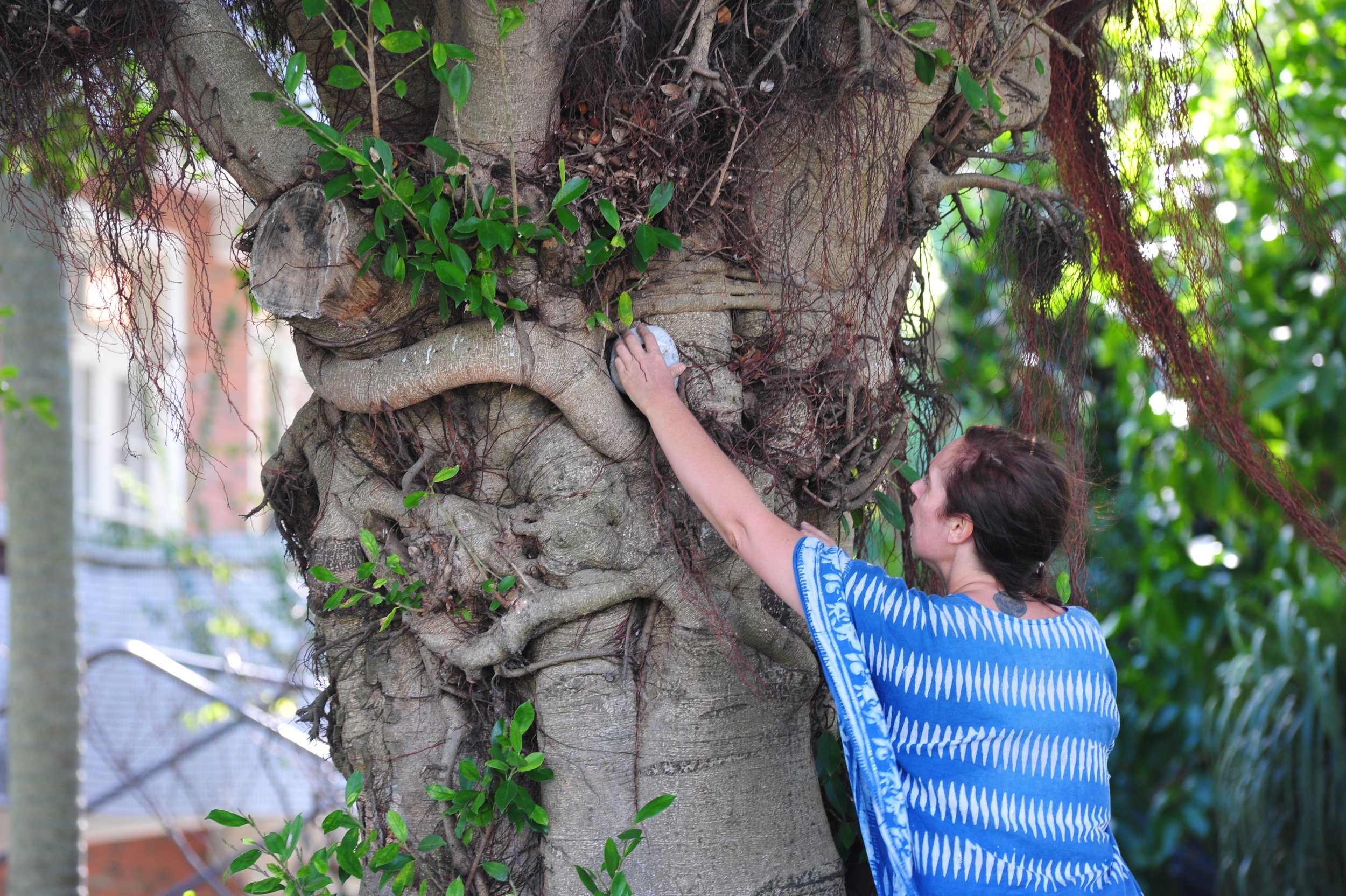THE heART OF Chinese LANGUAGE
FORGOTTEN FORMS - Public Art
Mandarin Chinese is not my Mother tongue but I have come to understand that language can be as artistic as visual language is, and that we can find resonance in tongues that are not our native own. Perhaps it is the sound that lands in our bodies and sings to us. Maybe it's the diagrammatic dance of the visual characters of Chinese that seduces and informs equally when studied or explored.
The vitality and aliveness of these ancient sounds, symbols and brush strokes carry stories, are stitched with jewels of old but relevant wisdom - and have vast and abstract concepts woven through them -
I was drawn to Taiwan to reside some years ago and have felt at home here ever since I landed - I had dreams about learning this language and so wove this dream into my waking life and stopped teaching Art to study. I wanted to explore these ancient codes. I began to have returning memories of the Chinese language, and of having lived a life before in ancient Chinese culture. Upon studying, something within me was activated and I was intuitively and immediately decomposing the characters; falling into caverns of curiosity surrounding the way in which the components came together and what this was communicating - it felt like a texture to the form of the characters and I was feeling them, touching their essence somehow. I was receiving messages from the Heavens about the characters and remembering ancient Taoist wisdom and Philosophy.
In a wonderful calligraphy shop in Banqiao district, a lady handed me a book one day on the Xiao3 Zhuan4 script of the Qin Dynasty. The curving bodies of the characters and their simplified form was speaking to me in a visual language of symbols which I could access and understand. ‘I remember’, my Soul was saying. These characters are so vastly different in some instances, to the characters of now, but it felt important to me to start revisiting the aged and symbolic quality of these forgotten forms.
I am in deep reverence for the rich tapestry-like quality of this language, past and present forms and all the shapes in between - How the characters swell with meaning and how they are shaped by the context of the conversation entirely. Without the backdrop as known, it is like an untitled painting without an explanatory passage by its side. There is a mystery perhaps - or a silent acknowledgement of the beautiful way in which form and sound come together, how they marry and strengthen or bolster one another. The sound disappears off into the ether, back into nothingness, but the form stays.
Historically the vast number of characters have been taught in a mechanical way. As with all Mother tongues, the closeness of the language, and the need to become able to communicate quickly, takes precedence above a felt understanding often. Ancient Roman Architect Vitruvius, described the building of structures to be concerned essentially with strength, functionality and beauty - these principles are always listed in this order. What then if we consider language and Chinese character composition in this regard? The radicals and components are the strength and building blocks of words. Then as they come together in different variations, meaning and beauty accumulates.
Suppose we decompose the hierarchy of this list and balance beauty and emotion with functionality. In Mathematical terms, but I sense this can be far more widely applied, “If it is beautiful then it must be correct.”
Perhaps It is a human tendency to sink into habitual ways, and to take things as they were presented to us when we were young. Studying Chinese has certainly encouraged me to start exploring the English language in deeper and more deconstructive ways. Often the essence of words I assumed I knew have an entirely alternate meaning when traced back etymologically. If we become more interrogative - especially of the things that we once absorbed or learnt more mechanically, then we can find new life and new meaning in the languages that we believe we know so intimately. Sometimes it is the things that are most close to us that are the most obscured. If we can find a distance or start looking at our languages in new ways, maybe we can find the beauty and the essence of the words that we use everyday.
Since the only constant is change, can we deeply respect, but also reframe, the traditions of the past, so that they work in our contemporary climate? Introducing a sense of play and experimentality in the process of calligraphy and Chinese language learning can help to breathe new life into old words and allow for a more integrated and loving embodiment of this rich and complex language.
FORGOTTEN FORMS - is a public Art piece that dwells beneath and with this exceptional two trunked Bodhi tree tree and alongside the path of the Tamsui River in Bali District Northern Taiwan (the trail starts on the link below). It is a growing and interactive project - Please feel free to participate with love and respect for this project by adding a pebble of a Chinese Character (old or current day) that you revere - The trail starts outside the beautiful Café 146 -
You can follow the growth of this project: @goldenflowerbeing and if you photograph please add the hashtag #forgottenforms and #Welovewords
中文不是我的母語,但我漸漸瞭解語言可以像視覺語言一樣具有藝術性,同樣能夠在不是屬於我自己的母語中找到共鳴。 或許是身體內在的聲音在呼喚著我們,也或許是中國文字的特性在視覺上如同圖解舞蹈般,在學習探索時也同時吸引著我。
這些自古流傳下來具有生命力與活力的聲調、符號與一筆一劃均夾帶著故事與非常寶貴的古老智慧,透過它們編織成廣闊而抽象的概念。
幾年前我被台灣吸引而居住在此,從我到台灣以來,就有一種歸鄉的感覺 - 我嚮往學習中文,因此把這個夢想付諸到我的生活中,並結束藝術教學,開始專心學習它。 我想探索這些年代久遠的密碼,並開始對中文有記憶,似乎曾經生活在以往的中國文化裡。 我內心的某些事情在學習過程中被啟動,並直覺的分解字體的結構,也
陷入在中國文字部件的組合方式及其想傳達訊息與溝通的好奇心 。我會意字體的構造,就某種程度來說,觸及到中國文字的精髓。 我感受到上天傳達出來有關中文字體的訊息,並想起自古以來道家的智慧和哲學。
有一天我在板橋一間非常好的書店裡,一位女士給我一本關於秦代小篆字體的書。 我體會到書裡字體筆順的的曲線及其簡化的形式對我而言,是一種以符號為表徵的視覺語言。我內在的靈魂說著"我記得這些事情"。 這些篆體在某些情形下與現在的字體非常不一樣。然而對我而言,重新探訪這些被遺忘的古老字形和其所象徵的特質對我來說很重要。
有史以來,多數的文字都是以機械式學習的方式在教學,如同所有的母語一樣,語言使用的的緊密程度與能夠迅速溝通的需求度往往勝過於感知上的理解。 古羅馬建築師維特魯威 (Vitruvius) 形容建築物的結構最必須要被考量的是: 力度、功能和美感——一直以來這些原則都是依照此順序排列。 但若以此面像來考慮語言和中文字的構成呢? 部首與部件即是構築文字的強度。 再者,當它們以不同的形式組合在一起時,意義和美感便會逐漸遞增。
若以上述列舉的三個層次結構為前提來拆解,並且以功能性來平衡文字的美感和情感。以數學上的學術用語更廣泛地被應用來說,可以是 “ 假設它是美的,它一定是正確的。
也許人們習於慣性,且因循年輕時看待事物的方式來看待事情。 學習中文無疑鼓勵我開始以更深入、更具解構性的方式去探索英文。 當從詞源上追溯時,往往我認為早已經知道的單字其本質常常具有完全不同的意義。 若是我們更進一步習慣性的去質疑那些我們曾經吸收或學習過的事物,我們也可以在自己非常熟悉的語言中找到新的生命和新的意義。 有時最接近我們的事務反而也是最難以理解的。 如果我們能有距離或開始以新的方式來看待我們的語言,或許就能找到日常使用的詞彙之美與精髓。
既然唯一不變的就是變化,我們是否可以更深的去尊重,並且以不同的方式來看待過去的傳統,讓它們在我們現代的環境中發揮作用呢? 在書法和中文學習的過程中帶入遊戲和實驗性,有助於將舊的字詞注入新的活力,也能讓這種豐富而復雜的語言更完整,更充滿愛的體現。
Forgotten Forms - 是一個公共藝術作品 , 沿著淡水河邊的小路走。您可以在上面鏈接的位置訪問不斷增長的項目。
你可以透過IG @goldenflowerbeing 關注這個計畫的成長; 如果你以拍照方式,請添加主題標籤
#forgottenforms 和 #Welovewords







































